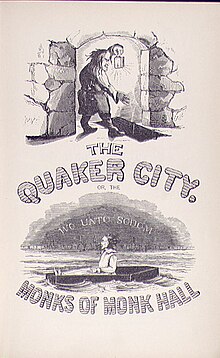 Illustrated cover by F. O. C. Darley | |
| Author | George Lippard |
|---|---|
Publication date | 1845 |
The Quaker City; or, The Monks of Monk Hall is a city mystery novel by Philadelphia writer George Lippard, first published in 1845.
 Illustrated cover by F. O. C. Darley | |
| Author | George Lippard |
|---|---|
Publication date | 1845 |
The Quaker City; or, The Monks of Monk Hall is a city mystery novel by Philadelphia writer George Lippard, first published in 1845.
The Quaker City describes four main characters during the course of three days and nights. The story is set mostly in a Philadelphia mansion named "Monk Hall", which serves as a private gentlemen's club and is also secretly a brothel and opium den patronized by some of the city's most respected citizens. The main characters engage in various acts of debauchery, including the attempt at deflowering a young maiden. Devil-Bug, one of the book's most memorable characters, serves as the hall's caretaker and doorman.
The Quaker City is based partly on the March 1843 New Jersey trial of Singleton Mercer. [1] Mercer was accused of the murder of Mahlon Hutchinson Heberton aboard the Philadelphia-Camden ferry vessel Dido on February 10, 1843. Mercer alleged that Heberton, only five days before he shot him, had lured his sixteen-year old sister into a brothel and raped her at gunpoint. He entered a plea of insanity and was found not guilty. The trial occurred only two months after Edgar Allan Poe's short story "The Tell-Tale Heart", a story based on other murder trials employing the insanity defense; Mercer's defense attorney acknowledged the "object of ridicule" which an insanity defense had become. Nonetheless, a verdict of not-guilty was rendered after less than an hour of jury deliberation, and the family and the lawyer of young Mercer were greeted by a cheering crowd while disembarking from the same Philadelphia-Camden ferry line on which the killing occurred. Lippard employed the seduction aspect of the trial as a metaphor for the oppression of the helpless.
The Quaker City was the best-selling novel in America before Uncle Tom's Cabin . [2] When it appeared in print during 1845, it sold 60,000 copies during its first year and at least 10,000 copies throughout the next decade. [3] Its success made Lippard one of the best-paid American writers of the 1840s, earning $3,000 to $4,000 a year. [4]
Lippard took advantage of the popularity of his novel The Quaker City to establish his own weekly periodical, also named The Quaker City. He advertised it as "A Popular Journal, devoted to such matters of Literature and news as will interest the great mass of readers". [5] Its first issue was published December 30, 1848. [6]
In The Quaker City; or; The Monks of Monks Hall, Lippard intended to expose the hypocrisy of the Philadelphia elite as well as the darker underside of American capitalism and urbanization. Lippard's Philadelphia is populated with parsimonious bankers, foppish drunkards, adulterers, sadistic murderers, reverend rakes, and confidence men, all of whom the author depicts as potential threats to the Republic. It is considered the first muckraking novel. [7]
Many people were offended by the story's lurid elements. The book may also have prompted new laws, such as New York's 1849 enactment of an anti-seduction law.
The Monks of Monk Hall outraged some readers with its lingering descriptions of "heaving bosoms" but such descriptions also drew readers and increased book sales. A stage version was prepared but banned in Philadelphia for fear of riots. [1]

Edgar Allan Poe was an American writer, poet, author, editor, and literary critic who is best known for his poetry and short stories, particularly his tales of mystery and the macabre. He is widely regarded as a central figure of Romanticism and Gothic fiction in the United States, and of American literature. Poe was one of the country's earliest practitioners of the short story, and is considered the inventor of the detective fiction genre, as well as a significant contributor to the emerging genre of science fiction. He is the first well-known American writer to earn a living through writing alone, resulting in a financially difficult life and career.

"The Black Cat" is a short story by American writer Edgar Allan Poe. It was first published in the August 19, 1843, edition of The Saturday Evening Post. In the story, an unnamed narrator has a strong affection for pets until he perversely turns to abusing them. His favorite, a pet black cat, bites him one night and the narrator punishes it by cutting its eye out and then hanging it from a tree. The home burns down but one remaining wall shows a burned outline of a cat hanging from a noose. He soon finds another black cat, similar to the first except for a white mark on its chest, but he develops a hatred for it as well. He attempts to kill the cat with an axe but his wife stops him; instead, the narrator murders his wife. He conceals the body behind a brick wall in his basement. The police soon come and, after the narrator's tapping on the wall is met with a shrieking sound, they find not only the wife's corpse but also the black cat that had been accidentally walled in with the body and alerted them with its cry.

"The Raven" is a narrative poem by American writer Edgar Allan Poe. First published in January 1845, the poem is often noted for its musicality, stylized language, and supernatural atmosphere. It tells of a distraught lover who is paid a mysterious visit by a talking raven. The lover, often identified as a student, is lamenting the loss of his love, Lenore. Sitting on a bust of Pallas, the raven seems to further antagonize the protagonist with its constant repetition of the word "Nevermore". The poem makes use of folk, mythological, religious, and classical references.

"The Murders in the Rue Morgue" is a short story by Edgar Allan Poe published in Graham's Magazine in 1841. It has been described as the first modern detective story; Poe referred to it as one of his "tales of ratiocination".

"The Tell-Tale Heart" is a short story by American writer Edgar Allan Poe, first published in 1843. It is related by an unnamed narrator who endeavors to convince the reader of the narrator's sanity while simultaneously describing a murder the narrator committed. The victim was an old man with a filmy pale blue "vulture-eye", as the narrator calls it. The narrator emphasizes the careful calculation of the murder, attempting the perfect crime, complete with dismembering the body in the bathtub and hiding it under the floorboards. Ultimately, the narrator's actions result in hearing a thumping sound, which the narrator interprets as the dead man's beating heart.

Charles Brockden Brown was an American novelist, historian, and editor of the Early National period.
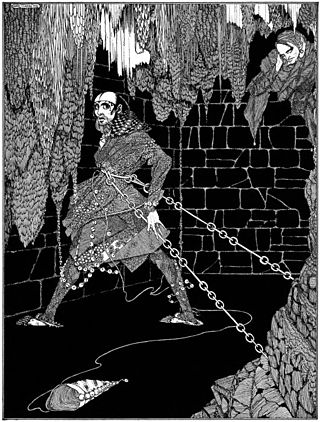
"The Cask of Amontillado" is a short story by the American writer Edgar Allan Poe, first published in the November 1846 issue of Godey's Lady's Book. The story, set in an unnamed Italian city at carnival time, is about a man taking fatal revenge on a friend who, he believes, has insulted him. Like several of Poe's stories, and in keeping with the 19th-century fascination with the subject, the narrative follows a person being buried alive – in this case, by immurement. As in "The Black Cat" and "The Tell-Tale Heart", Poe conveys the story from the murderer's perspective.

"The Gold-Bug" is a short story by American writer Edgar Allan Poe published in 1843. The plot follows William Legrand, who becomes fixated on an unusual gold-colored bug he has discovered. His servant Jupiter fears that Legrand is going insane and goes to Legrand's friend, an unnamed narrator, who agrees to visit his old friend. Legrand pulls the other two into an adventure after deciphering a secret message that will lead to a buried treasure.
Harold Schechter is an American true crime writer who specializes in serial killers. He is a Professor Emeritus at Queens College, City University of New York where he taught classes in American literature and myth criticism for forty-two years. Schechter's essays have appeared in numerous publications including The New York Times, The Wall Street Journal, The Los Angeles Times, and the International Herald Tribune. He is the editor of the Library of America volume, True Crime: An American Anthology. His newest book, published in September 2023, is Murderabilia: A History of Crime in 100 Objects.

The Narrative of Arthur Gordon Pym of Nantucket, written in 1838, is the only complete novel by American writer Edgar Allan Poe. The work relates the tale of the young Arthur Gordon Pym, who stows away aboard a whaling ship called the Grampus. Various adventures and misadventures befall Pym, including shipwreck, mutiny, and cannibalism, before he is saved by the crew of the Jane Guy. Aboard this vessel, Pym and a sailor named Dirk Peters continue their adventures farther south. Docking on land, they encounter hostile, black-skinned natives before escaping back to the ocean. The novel ends abruptly as Pym and Peters continue toward the South Pole.

Le ChevalierC. Auguste Dupin is a fictional character created by Edgar Allan Poe. Dupin made his first appearance in Poe's 1841 short story "The Murders in the Rue Morgue", widely considered the first detective fiction story. He reappears in "The Mystery of Marie Rogêt" (1842) and "The Purloined Letter" (1844).
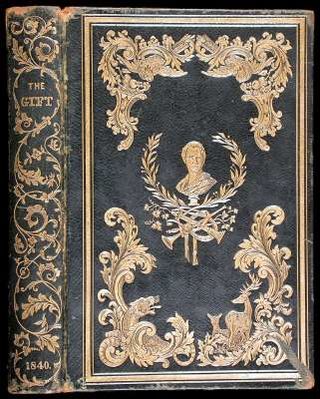
"William Wilson" is a short story by American writer Edgar Allan Poe, first published in 1839 in The Gift, with a setting inspired by Poe's formative years on the outskirts of London. The tale features a doppelgänger. It also appeared in the 1840 collection Tales of the Grotesque and Arabesque, and has been adapted several times.
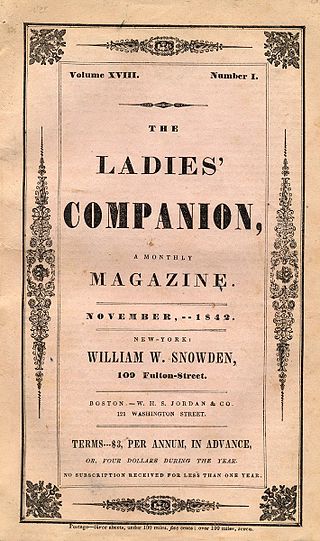
"The Mystery of Marie Rogêt", often subtitled A Sequel to "The Murders in the Rue Morgue", is a short story by American writer Edgar Allan Poe written in 1842. This is the first murder mystery based on the details of a real crime. It first appeared in Snowden's Ladies' Companion in three installments, November and December 1842 and February 1843. Poe referred to it as one of his "tales of ratiocination".
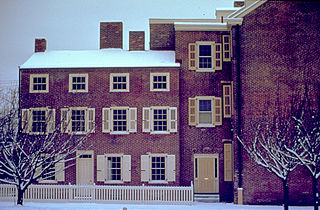
The Edgar Allan Poe National Historic Site is a preserved home once rented by American author Edgar Allan Poe, located at 532 N. 7th Street, in the Spring Garden neighborhood of Philadelphia, Pennsylvania. Though Poe lived in many houses over several years in Philadelphia, it is the only one which still survives. It was designated a National Historic Landmark in 1962.

The Mysteries of Paris is a novel by the French writer Eugène Sue. It was published serially in 90 parts in Journal des débats from 19 June 1842 until 15 October 1843, making it one of the first serial novels published in France. It was an instant success and singlehandedly increased the circulation of Journal des débats. It founded the "city mysteries" genre, spawning many imitations.
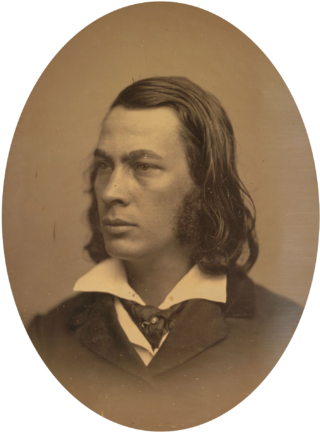
George Lippard was a 19th-century American novelist, journalist, playwright, social activist, and labor organizer. He was a popular author in antebellum America.

Graham's Magazine was a nineteenth-century periodical based in Philadelphia established by George Rex Graham and published from 1840 to 1858. It was alternatively referred to as Graham's Lady's and Gentleman's Magazine, Graham's Magazine of Literature and Art, Graham's American Monthly Magazine of Literature and Art, and Graham's Illustrated Magazine of Literature, Romance, Art, and Fashion.

"The Imp of the Perverse" is a short story by 19th-century American author and critic Edgar Allan Poe. Beginning as an essay, it discusses the narrator's self-destructive impulses, embodied as the symbolic metaphor of The Imp of the Perverse. The narrator describes this spirit as the agent that tempts a person to do things "merely because we feel we should not."

David S. Reynolds is an American literary critic, biographer, and historian who has written about American literature and culture. He is the author or editor of fifteen books, on the Civil War era—including figures such as Walt Whitman, Abraham Lincoln, Herman Melville, Nathaniel Hawthorne, Edgar Allan Poe, Ralph Waldo Emerson, Henry David Thoreau, Emily Dickinson, Harriet Beecher Stowe, George Lippard, and John Brown. Reynolds has been awarded the Bancroft Prize, the Lincoln Prize, the Christian Gauss Award, the Ambassador Book Award, the Gustavus Myers Book Award, the John Hope Franklin Prize, and was a finalist for the National Book Critics Circle Award. He is a regular reviewer for The New York Times Book Review.

The Flag of Our Union (est.1846) was a weekly story paper published in Boston, Massachusetts, in the mid-19th century. In addition to news it featured works of fiction and poetry including contributions from notable writers such as Louisa May Alcott and Edgar Allan Poe. Publisher Frederick Gleason began The Flag in 1846, a "miscellaneous family journal, containing news, wit, humor, and romance -- independent of party or sect." Original stories, verse, and illustration appeared in the paper, as well as brief news items on local, national and international current events. Maturin Murray Ballou served as editor. In 1849, Gleason's office was located "on the corner of Court and Tremont Streets" in Boston.